Advertisements
Advertisements
प्रश्न
Observe the following figure and answer the questions given under it:
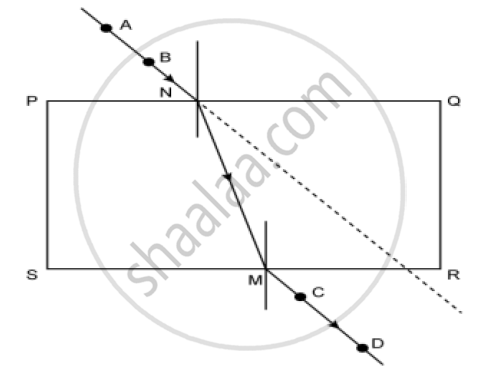
1) How many times does refraction take place in the above figure?
2) What happens to the ray of light when it passes from air to glass?
3) What happens to the ray of light when it passes from glass to air?
4) What are the rays AB and CD in the figure called?
5) Define refraction.
उत्तर
An expression for heat produced in a conductor by using Joule's experiment:
1) Refraction occurs twice, once at Point N and the second time at Point M.
2) Air is rarer than glass. So, when light passes from the rarer medium to the denser medium, it bends towards the normal.
3) When light passes from the denser (glass) medium to the rarer (air) medium, it bends away from the normal.
4) Ray AB is called the incident ray, and ray CD is called the emergent ray.
5) Refraction of light is the phenomenon of change in the direction of propagation of light when it passes obliquely from one transparent medium to another.
APPEARS IN
संबंधित प्रश्न
Write a short note on dispersion of light.
Explain how the formation of a rainbow occurs.
A student traces the path of a ray of light passing through a rectangular glass slab and marks the angle of incidence i, angle of refraction r and angle of emergence e, as shown.
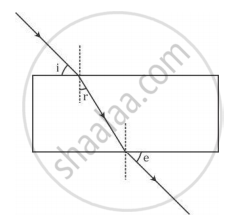
The correctly marked angle(s) is/are
(A) ∠ i only
(B) ∠ e only
(C) ∠ r only
(D) ∠ i and ∠ e
State the dependence of angle of deviation On the refractive index of the material of the prism.
A ray of light passes from water to air. How does the speed of light change?
When light travels from a rarer to a denser medium, its speed ______.
The highest refractive index is of ______.
A light ray in passing from water to a medium
(a) speeds up
(b) slows down. In each case, give one example of the medium.
How does the speed of light change when it passes from glass to water?
Fig 4.31 below shows a light ray of single colour incident normally on two prisms A and B. In each case draw the path of the ray of light as it enters and emerges out of the prism. Mark the angle wherever necessary.
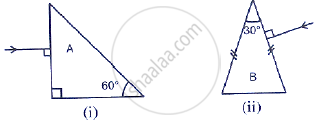
The refractive index of glass is 1.5. From a point P inside a glass block, draw rays PA, PB and PC incident on the glass air surface at an angle of incidence 30°, 42° and 60° respectively.
- In the diagram show the approximate direction of these rays as they emerge out of the block.
- What is the angle of refraction for the ray PB?
`("Take" sin 42° =2/3)`
While tracing the path of a ray of light passing through a rectangular glass slab a student tabulated his observations as given below:
|
S.NO. |
∠i |
∠r |
∠e |
|
I |
60° |
40° |
61° |
|
II |
50° |
36° |
51° |
|
III |
40° |
28° |
39° |
|
IV |
30° |
20° |
31° |
The correct observations is:
(A) I
(B) II
(C) III
(D) IV
Four students showed the following traces of the path of a ray of light passing through a rectangular glass slab.

The trace most likely to be correct is that of student
(A) I
(B) II
(C) III
(D) IV
While performing the experiment on tracing the path of a ray of light through a rectangular glass slab, in which of the following experimental set-ups is a student likely to get best results? P1 and P2 are the positions of pins fixed by him.
(A) I
(B) II
(C) III
(D) IV
-
- the angle of refraction and
- the angle of deviation for the ray?
Fill in the blank to complete the following sentence:
When light travels from a rarer to a denser medium, it bends ...........
Fig shows a lens as a combination of a glass block and two prisms.
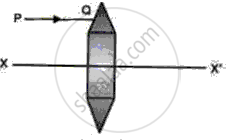
(i) Name the lens formed by the combination.
(ii) what is the XX' called?
(iii) Complete the ray diagram and show the path of the incident ray PQ after passing through the lens.
(iv) The final emergent ray will either meet XX' at a point or appear to come from a point on XX'. what is the point called?
Why do the faces of persons sitting around campfire appear to shimmer?
Why is the colour red used as a sign of danger?
During sunset and sunrise, the sun is seen when it is slightly below the horizon. Give reason.
Write a relation between the angle of incidence (i), angle of emergence (e), angle of the prism (A), and angle of deviation (d) for a ray of light passing through an equilateral prism.
Name the material for which the refractive index is found to be maximum.
Comment on the statement ‘The refractive index of glass is 3/2.’
Express the refractive index μ of a medium in terms of the velocity of light.
Explain briefly what causes the twinkling of stars at night.
The refractive index of air with respect to glass is defined: as gµa = sin i/sin r
Write down a similar expression for aµg in terms of angle i and r.
A ray of monochromatic light is incident from air into a glass slab. Draw a labelled ray diagram indicating the change in its path till it emerges out of the slab. In the diagram, mark the angle of incidence (i) and the angle of refraction (r) at the first interface. How is the refractive index of glass related to the angles i and r?
Draw ray of light bending towards the normal while passing from air to glass. Label your diagrams.
The figure shows two prisms A and B. A monochromatic ray of light PO is incident at the face of the prism A. Complete the diagram to show the path of the ray till it emerges out of the prism B.
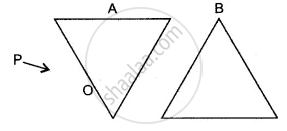
The diagram shows the path of a ray of light through a rectangular glass block placed in a liquid of uniform density.

Show with the help of a ray diagram the path of the ray when incident ray normally falls on the first surface of the glass block and passes through the block and the liquid.
The diagram shows the path of a ray of light through a rectangular glass block placed in a liquid of uniform density.

What should be the rate of the speed of light through the liquid to the speed through the glass so that there is no refraction of light at the boundaries of the glass block when the system is illuminated by the light of one colour?
Consider these indices of refraction: glass: 1.52; air: 1.0003; water: 1.333. Based on the refractive indices of three materials, arrange the speed of light through them in decreasing order.
A ray of light is incident at an angle of 45° on one face of a rectangular glass slab of thickness 10 cm and refractive index 3/2. Calculate the lateral shift produced ______.
